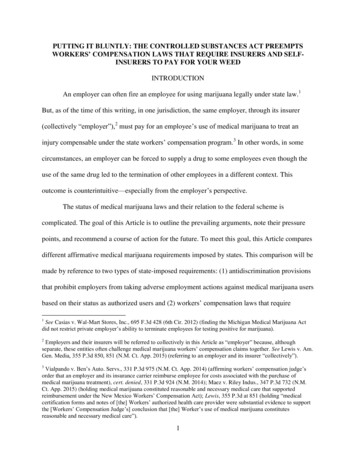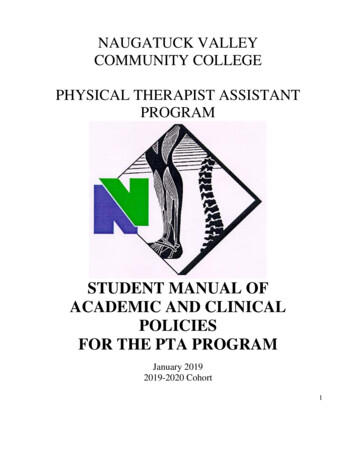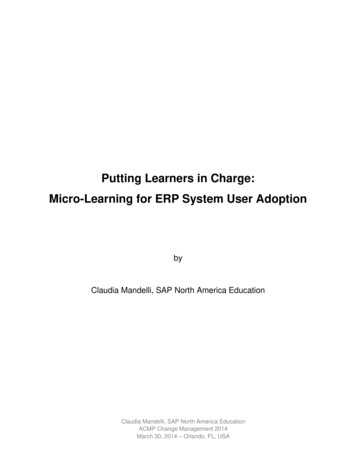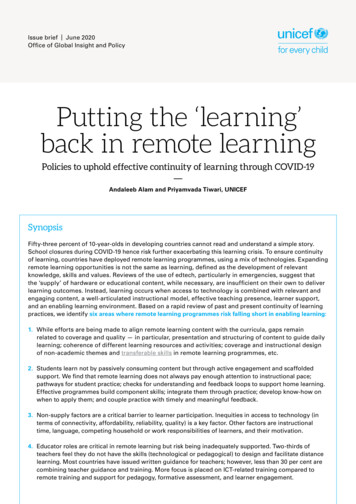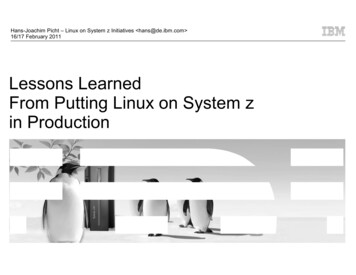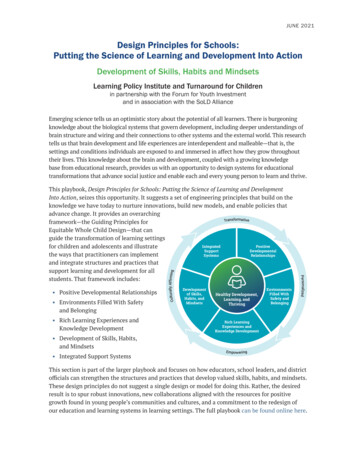
Transcription
JUNE 2021Design Principles for Schools:Putting the Science of Learning and Development Into ActionDevelopment of Skills, Habits and MindsetsLearning Policy Institute and Turnaround for Childrenin partnership with the Forum for Youth Investmentand in association with the SoLD AllianceEmerging science tells us an optimistic story about the potential of all learners. There is burgeoningknowledge about the biological systems that govern development, including deeper understandings ofbrain structure and wiring and their connections to other systems and the external world. This researchtells us that brain development and life experiences are interdependent and malleable—that is, thesettings and conditions individuals are exposed to and immersed in affect how they grow throughouttheir lives. This knowledge about the brain and development, coupled with a growing knowledgebase from educational research, provides us with an opportunity to design systems for educationaltransformations that advance social justice and enable each and every young person to learn and thrive. Environments Filled With Safetyand Belonging Rich Learning Experiences andKnowledge Development Development of Skills, Habits,and Mindsets Integrated Support Systemsy AffirmingCulturall Positive Developmental RelationshipsDevelopmentof Skills,Habits, andMindsetsHealthy Development,Learning, andThrivingEnvironmentsFilled WithSafety andBelongingPersonalizedThis playbook, Design Principles for Schools: Putting the Science of Learning and DevelopmentInto Action, seizes this opportunity. It suggests a set of engineering principles that build on theknowledge we have today to nurture innovations, build new models, and enable policies thatadvance change. It provides an overarchingTransformativeframework—the Guiding Principles forEquitable Whole Child Design—that canguide the transformation of learning settingsIntegratedPositivefor children and adolescents and illustrateSupportDevelopmentalthe ways that practitioners can implementSystemsRelationshipsand integrate structures and practices thatsupport learning and development for allstudents. That framework includes:Rich LearningExperiences andKnowledge DevelopmentE m p o w erin gThis section is part of the larger playbook and focuses on how educators, school leaders, and districtofficials can strengthen the structures and practices that develop valued skills, habits, and mindsets.These design principles do not suggest a single design or model for doing this. Rather, the desiredresult is to spur robust innovations, new collaborations aligned with the resources for positivegrowth found in young people’s communities and cultures, and a commitment to the redesign ofour education and learning systems in learning settings. The full playbook can be found online here.
Development of Skills, Habits, and MindsetsDeveloping Habits of Mind and Heart at East Palo Alto AcademyEast Palo Alto Academy (EPAA)—a small public high school launched in a low-income communityin California once so violence-ridden it was identified as the murder capital of the United States—transformed student outcomes by incorporating practices built on the science of learning anddevelopment. In a district where two thirds of students once failed to graduate, the new schoolenabled 90% of students to graduate and 90% to go on to college by creating the conditions forcognitive, social, and emotional learning.As in many other new schools, teachers began by identifying the fundamental competenciesnecessary for success in school and in life and then infusing them into every aspect of the school.The Five Community Habits developed by the staff in the first year—personal responsibility, socialresponsibility, critical and creative thinking, application of knowledge, and communication—were thebasis of rubrics used for guidance and evaluation in every class, every year, by every teacher.The social, emotional, and cognitive skills, habits, and mindsets incorporated into the rubricsinclude personal awareness and self-management for attendance, participation, personal honesty,and care for others. They also include interaction and collaboration skills, empathy and perspectivetaking, and community building. Executive functions like planning, organizing, and managingprojects; metacognitive skills like reflection for self-improvement; and capacities for perseveranceexhibited by willingness to revise work are also incorporated into the rubric.This framework, which guided the development of curriculum and the evaluation of student work, wasused to teach students in a consistent and persistent manner what it meant to be a student, a worker,and a member of the EPAA community. Some skills, such as conflict resolution and study skills,were taught in advisory classes, while all were taught, modeled, and reinforced in academic andco-curricular settings. Because students were constantly reflecting on the skills in self-assessments,exhibitions, and student-led conferences, they internalized them deeply. As one student noted,“The [Five Habits] rubric has been the best thing for me over the last 4 years.” Because teachersincorporated these skills and habits into content classes as well as advisory classes, students grewto have a thorough understanding of the standards, commonly referenced them, and knew whatwas needed to meet them. Ericka, a student from the first graduating class, demonstrated her deepunderstanding of the habit of social responsibility as she reflected at her senior exhibition:It was hard for me, because freshman year I was just really a cocky individual. I thought I knewit all; I didn’t want to work for anybody else, because I was big-headed. And part of this habit ishow well you interact in a group. How well do you work with people who are not like you? If I putyou in a group with [two other students], can you work with them? Can you get the job done? Howdo you move your group forward? Are you interrupting me every time I’m trying to speak? Iwould apply this [to the challenge of] being able to work with people who are not like you, whohave different backgrounds from you, who have different viewpoints from you. Being able totackle that in high school I think [will make it] easier for me to tackle it when I go to college.Source: Adapted from Darling-Hammond, L. Altamirano, R., Ramos-Beban, N., & Hyler, M. (2016). Be the Change:Reinventing School for Student Success. Teachers College Press.84LEARNING POLICY INSTITUTE & TURNAROUND FOR CHILDREN Design Principles for Schools
Overview of the Development of Skills, Habits, and MindsetsThis brief glimpse into East Palo Alto Academy illustrates how a school can embed social,emotional, and cognitive skills and habits into an academically rigorous curriculum and empowerstudents to practice these skills with growing independence. When such skills are practicedsufficiently to become habits, they support the development of engaged, productive, and effectivelearners in ways that transfer to new situations. By integrating these skills in the curriculumthroughout the school day and across the 4 years, teachers at East Palo Alto Academy recognizedthat the development of complex dynamic skills is a progression that cannot occur at a singlemoment in time or in isolation from other abilities.The educators at East Palo Alto Academy know that in order for young people to learn and thrive,they need rich opportunities to develop their whole selves. They created a simple framework thatall school stakeholders could use to foster important cognitive, affective, and social skills along withdomain-specific knowledge. This skill development was nested in an enabling environment full of richexperiences and trusting relationships that empowered students as active agents in their own learning.Research across a diverse set of fields confirms that these kinds of skills, along with mindsets thatsupport growth, belonging, and purpose, are critical for success in school and beyond. For example,the emotions young people have while learning affect how deeply they engage with activities andcontent. Positive emotions, such as a sense of personal value, along with interest and excitement,open up the mind to learning. Negative emotions, such as fear of failure, anxiety, and self-doubt,reduce the capacity of the brain to process information and to learn. It is our emotions that engageus or shut us down, and it is the development of productive skills, habits, and mindsets thatsubstantially drives our emotions.Turnaround for Children’s Building Blocks for Learning framework (see Figure 5.1) offers acomprehensive means for understanding how these skills are related and how they develop.Foundational skills (e.g., self-regulation, executive functions, self- and social awareness, and stressmanagement) and mindsets (e.g., growth mindset, self-efficacy, and sense of belonging) lay thegroundwork for higher-order skills and mindsets (e.g., agency, academic tenacity, curiosity, etc.).The framework acknowledges that instructional and contextual factors of classrooms substantiallyinfluence student outcomes. Students do not always have the same start in life or follow a smoothpath through it, but through sustained and supportive relationships and personalized experiences,all students have the potential to succeed as learners.Why Developing Skills, Habits, and Mindsets Is Important:What the Science SaysLearning is social, emotional, cognitive, and academic. How does any student become aproductive learner? What skills must they have? The science tells us that learning is integrated: Thereare not separate parts of the brain that support academic skills and social skills, for example. Theparts of the brain are cross-wired and functionally interconnected. For students to become engaged,effective learners, educators need to simultaneously develop content-specific knowledge and skillsalong with cognitive, emotional, and social skills. These skills, including executive functions, growthmindset, social awareness, resilience and perseverance, metacognition, curiosity, and self-direction,are malleable: They are not “hardwired” but develop in response to experience. All are correlated withachievement, and all can be taught, modeled, and practiced just like traditional academic skills.LEARNING POLICY INSTITUTE & TURNAROUND FOR CHILDREN Design Principles for Schools85
Figure 5.1Building Blocks for LearningSource: Stafford-Brizard, K. B. (2016). Building blocks for learning: A framework for comprehensive student development.Turnaround for Children. earningx-2.pdf.Social, emotional, and cognitive skills are interrelated and develop as a progression.Cognitive skills like self-regulation, executive functions, and problem-solving interact withemotional skills, such as empathy, emotion recognition, and regulation, and with social skills,including cooperation and communication. These interacting skills develop progressively, but notas a fixed, linear sequence: As with other skills, there are bursts and plateaus. Higher-order skillsand abilities, when present, are a combination of foundational social, emotional, cognitive, andacademic skill development. When teachers understand that these skills progress in concert withone another, they can design learning experiences that simultaneously build diverse learning skills,supporting engagement and effort instead of singularly focusing on facts and procedures in a givenarea without attending to social and emotional considerations.Learning of these skills is influenced by relationships and experiences. Learning is highlycontext sensitive. A child’s skill and mindset development relies on an ongoing, dynamicinterconnectedness between biology and environment, including relationships and cultural andcontextual influences, resulting in significant variation within and across individuals over time.This contrasts with the idea of universal, fixed steps or stages of development. The norm is diversedevelopmental pathways—not missed opportunities, but rather multiple opportunities to develop86LEARNING POLICY INSTITUTE & TURNAROUND FOR CHILDREN Design Principles for Schools
new skills and/or catch up. Because each student’s development is nonlinear, with its own uniquepathways and pacing that are highly responsive to positive contextual influences and support,the unique challenge of schools is to design personalized, supportive developmental learningexperiences for all children, no matter their starting point.This extends to the development of social, emotional, and cognitive skills, which should be taughtthroughout childhood and adolescence and may need particular attention when students facechronic, unbuffered stress due to adversity or oppression. In these cases, the development offoundational skills and mindsets, including self-regulation, stress management, and executivefunction, are at risk. These skills are exquisitely sensitive to the hormone cortisol.The primary energy source for the wiring of the brain is human connection; the neurochemicalsand hormones that are released through human relationships are the fuel causing neurons to fireand connect. As Hebb’s Law states, “Neurons that fire together, wire together.” The brain getsincreasingly wired, and as it does, we become able to do increasingly complex things, whetherit is reading, riding a bike, or gaining resilience. In his 1984 2 Sigma study, Benjamin Bloomdemonstrated that building highly favorable conditions into the environments in which childrengrow and learn steeply improves equity of experience and opportunity.1 His proxy for highlyfavorable conditions was an individual tutor. He found that the experience of individual tutoringcould take a student performing at the 50th percentile and move their performance up by twostandard deviations to the 98th percentile. When he studied his data, he realized that the activeingredient that generated the outcomes he got was access to both the content and the adult–student interaction—the relationship.What Can Schools Do to Develop Skills, Habits, and Mindsets?For students to become engaged,effective learners, educatorsneed to simultaneously developcognitive, social, and emotionalskills along with content knowledgeand related academic skills. Thedevelopment of these skills is also aprerequisite for creating an equitableschool environment.For students to become engaged,effective learners, educators need tosimultaneously develop cognitive, social,and emotional skills along with contentknowledge and related academic skills.Many schools are now familiar with what is called social and emotional learning (SEL), as manyprograms have emerged to help teach these skills. The Collaborative for Academic, Social, andEmotional Learning (CASEL) provides one helpful framework for understanding the skills, habits,and mindsets that further social and emotional development. It also offers research on theeffectiveness of different approaches and programs, including self-awareness, self-management,social awareness, interpersonal skills, and responsible decision-making. (See Figure 5.2.)LEARNING POLICY INSTITUTE & TURNAROUND FOR CHILDREN Design Principles for Schools87
Figure 5.2CASEL’s SEL FrameworkSource: Collaborative for Social and Emotional Learning. (2020). CASEL’S SEL framework: What are the core competenceareas and where are they promoted? -SEL-Framework-11.2020.pdf.In addition, it is equally important to attend to the cognitive skills that are important for academicsuccess and development. Key among these are those related to executive function, which helplearners attend to tasks, plan their work, problem-solve in the face of emerging challenges, andmanage themselves in the learning process. These skills include the abilities to monitor andregulate one’s own actions; to organize, prioritize, and activate efforts in order to accomplishtasks; to focus, sustain, and shift attention and alertness as needed to attain goals; and to managefrustration and redirect efforts when needed. (See Figure 5.3.) The skills that are critical to successin school and in life are often assumed, rather than explicitly taught, and need an equally explicitcurricular approach.88LEARNING POLICY INSTITUTE & TURNAROUND FOR CHILDREN Design Principles for Schools
Figure 5.3Executive FunctionFunction andExecutiveand thethe AbilitiesAbilities ItIt SupportsSupportsFlexible ThinkingAdjusting behaviorto meet demandand resistdistractionWorking MemoryKeeping keyinformation in mindwhen using itEmotionalAwarenessKeeping feelingsin checkSelf-MonitoringHaving self-awarenessof how one is doing inthe momentImpulse ControlThinking beforeactingPlanning andPrioritizingSetting andmeeting goalsOrganizationKeeping track ofthings physicallyand mentallyTask InitiationTaking actionto get startedon rningcenter.com/executive-functioning/.LEARNING POLICY INSTITUTE & TURNAROUND FOR CHILDREN Design Principles for Schools89
These areas of learning need to be planned for and integrated across curriculum areas and across allsettings in the school. To achieve these aims, schools can incorporate the following structures andpractices to develop learners’ skills, habits, and mindsets: Structures that integrate cognitive, social, and emotional development intolearning include:- curricula and dedicated time that enable students to explicitly learn and practicevalued skills, habits, and mindsets (e.g., social and emotional learning or conflictresolution curricula);- opportunities and routines that reinforce skills, habits, and mindsets during everydayinstruction and school activities;- scaffolds that support executive functions like planning, organizing, implementing, andreflecting on tasks; and- collaboration protocols and rubrics that support interpersonal skill development in thecontext of subject matter classes. Practices that make learning and skill development visible and supported include:- strategies that reinforce skill, habit, and mindset development; affirm students’ abilitiesand assets; and provide appropriate scaffolds (e.g., using growth-oriented languageand practices);- strategies that help students describe their thinking and feelings; build self-awareness;and develop strategies for calming, self-management, and problem-solving; and- practices such as educator modeling, think-alouds, and metacognitive activities thatmake the development of cognitive, social, and emotional skills visible while conveyingwhat is possible.While we know that learning environments with these features help young people thrive in theirlearning and development, there are structures and policies in our current system that often inhibitthe implementation of such features. These obstacles have stemmed from the failure of systemsto recognize the connections among cognitive, social, emotional, and academic learning. Forexample, accountability structures in U.S. public education focused for many years exclusively ontest scores in reading and mathematics, coupled with a “no excuses” philosophy that minimized theimportance of social and emotional supports in schools. As a result, schools have often pared downthe development of skills to attend to tested subjects and their related content.This has exacerbated the perception that academic learning is distinct from the development ofhabits and mindsets, when in fact the research indicates that academic success is enhanced whenthey are developed together with acade
competencies that pervade all aspects of the school’s operations. For example, East Palo Alto . Academic Learning and Skill Development Through Community-Based Learning” for a deeper look at how one school integrates academic, co



